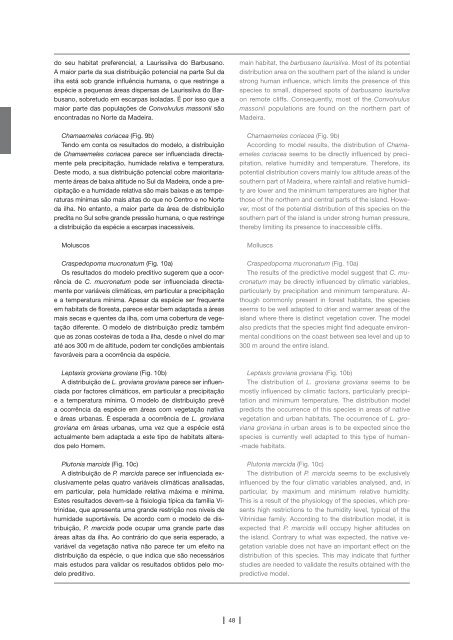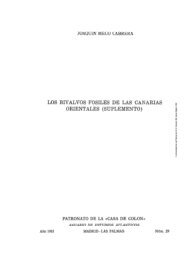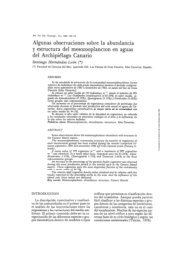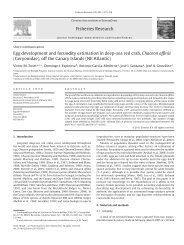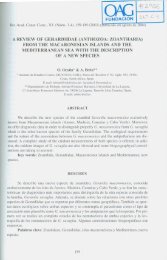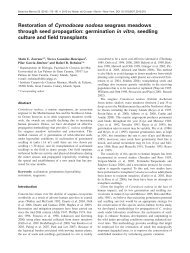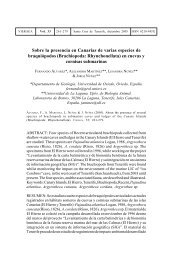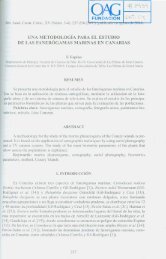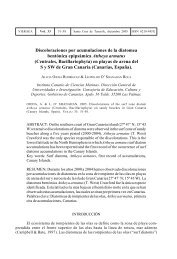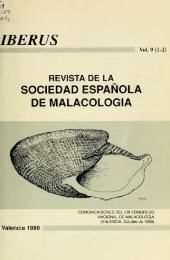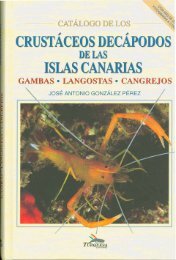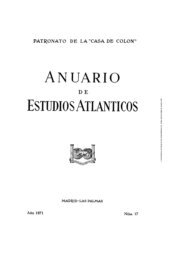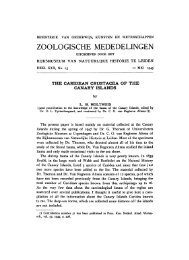of the madeira and selvagens archipelagos - redmic
of the madeira and selvagens archipelagos - redmic
of the madeira and selvagens archipelagos - redmic
Create successful ePaper yourself
Turn your PDF publications into a flip-book with our unique Google optimized e-Paper software.
do seu habitat preferencial, a Laurissilva do Barbusano.<br />
A maior parte da sua distribuição potencial na parte Sul da<br />
ilha está sob gr<strong>and</strong>e influência humana, o que restringe a<br />
espécie a pequenas áreas dispersas de Laurissilva do Barbusano,<br />
sobretudo em escarpas isoladas. É por isso que a<br />
maior parte das populações de Convolvulus massonii são<br />
encontradas no Norte da Madeira.<br />
Chamaemeles coriacea (Fig. 9b)<br />
Tendo em conta os resultados do modelo, a distribuição<br />
de Chamaemeles coriacea parece ser influenciada directamente<br />
pela precipitação, humidade relativa e temperatura.<br />
Deste modo, a sua distribuição potencial cobre maioritariamente<br />
áreas de baixa altitude no Sul da Madeira, onde a precipitação<br />
e a humidade relativa são mais baixas e as temperaturas<br />
mínimas são mais altas do que no Centro e no Norte<br />
da ilha. No entanto, a maior parte da área de distribuição<br />
predita no Sul s<strong>of</strong>re gr<strong>and</strong>e pressão humana, o que restringe<br />
a distribuição da espécie a escarpas inacessíveis.<br />
Moluscos<br />
Craspedopoma mucronatum (Fig. 10a)<br />
Os resultados do modelo preditivo sugerem que a ocorrência<br />
de C. mucronatum pode ser influenciada directamente<br />
por variáveis climáticas, em particular a precipitação<br />
e a temperatura mínima. Apesar da espécie ser frequente<br />
em habitats de floresta, parece estar bem adaptada a áreas<br />
mais secas e quentes da ilha, com uma cobertura de vegetação<br />
diferente. O modelo de distribuição prediz também<br />
que as zonas costeiras de toda a ilha, desde o nível do mar<br />
até aos 300 m de altitude, podem ter condições ambientais<br />
favoráveis para a ocorrência da espécie.<br />
Leptaxis groviana groviana (Fig. 10b)<br />
A distribuição de L. groviana groviana parece ser influenciada<br />
por factores climáticos, em particular a precipitação<br />
e a temperatura mínima. O modelo de distribuição prevê<br />
a ocorrência da espécie em áreas com vegetação nativa<br />
e áreas urbanas. É esperada a ocorrência de L. groviana<br />
groviana em áreas urbanas, uma vez que a espécie está<br />
actualmente bem adaptada a este tipo de habitats alterados<br />
pelo Homem.<br />
Plutonia marcida (Fig. 10c)<br />
A distribuição de P. marcida parece ser influenciada exclusivamente<br />
pelas quatro variáveis climáticas analisadas,<br />
em particular, pela humidade relativa máxima e mínima.<br />
Estes resultados devem -se à fisiologia típica da família Vitrinidae,<br />
que apresenta uma gr<strong>and</strong>e restrição nos níveis de<br />
humidade suportáveis. De acordo com o modelo de distribuição,<br />
P. marcida pode ocupar uma gr<strong>and</strong>e parte das<br />
áreas altas da ilha. Ao contrário do que seria esperado, a<br />
variável da vegetação nativa não parece ter um efeito na<br />
distribuição da espécie, o que indica que são necessários<br />
mais estudos para validar os resultados obtidos pelo modelo<br />
preditivo.<br />
48<br />
main habitat, <strong>the</strong> barbusano laurisilva. Most <strong>of</strong> its potential<br />
distribution area on <strong>the</strong> sou<strong>the</strong>rn part <strong>of</strong> <strong>the</strong> isl<strong>and</strong> is under<br />
strong human influence, which limits <strong>the</strong> presence <strong>of</strong> this<br />
species to small, dispersed spots <strong>of</strong> barbusano laurisilva<br />
on remote cliffs. Consequently, most <strong>of</strong> <strong>the</strong> Convolvulus<br />
massonii populations are found on <strong>the</strong> nor<strong>the</strong>rn part <strong>of</strong><br />
Madeira.<br />
Chamaemeles coriacea (Fig. 9b)<br />
According to model results, <strong>the</strong> distribution <strong>of</strong> Chamaemeles<br />
coriacea seems to be directly influenced by precipitation,<br />
relative humidity <strong>and</strong> temperature. Therefore, its<br />
potential distribution covers mainly low altitude areas <strong>of</strong> <strong>the</strong><br />
sou<strong>the</strong>rn part <strong>of</strong> Madeira, where rainfall <strong>and</strong> relative humidity<br />
are lower <strong>and</strong> <strong>the</strong> minimum temperatures are higher that<br />
those <strong>of</strong> <strong>the</strong> nor<strong>the</strong>rn <strong>and</strong> central parts <strong>of</strong> <strong>the</strong> isl<strong>and</strong>. However,<br />
most <strong>of</strong> <strong>the</strong> potential distribution <strong>of</strong> this species on <strong>the</strong><br />
sou<strong>the</strong>rn part <strong>of</strong> <strong>the</strong> isl<strong>and</strong> is under strong human pressure,<br />
<strong>the</strong>reby limiting its presence to inaccessible cliffs.<br />
Molluscs<br />
Craspedopoma mucronatum (Fig. 10a)<br />
The results <strong>of</strong> <strong>the</strong> predictive model suggest that C. mucronatum<br />
may be directly influenced by climatic variables,<br />
particularly by precipitation <strong>and</strong> minimum temperature. Although<br />
commonly present in forest habitats, <strong>the</strong> species<br />
seems to be well adapted to drier <strong>and</strong> warmer areas <strong>of</strong> <strong>the</strong><br />
isl<strong>and</strong> where <strong>the</strong>re is distinct vegetation cover. The model<br />
also predicts that <strong>the</strong> species might find adequate environmental<br />
conditions on <strong>the</strong> coast between sea level <strong>and</strong> up to<br />
300 m around <strong>the</strong> entire isl<strong>and</strong>.<br />
Leptaxis groviana groviana (Fig. 10b)<br />
The distribution <strong>of</strong> L. groviana groviana seems to be<br />
mostly influenced by climatic factors, particularly precipitation<br />
<strong>and</strong> minimum temperature. The distribution model<br />
predicts <strong>the</strong> occurrence <strong>of</strong> this species in areas <strong>of</strong> native<br />
vegetation <strong>and</strong> urban habitats. The occurrence <strong>of</strong> L. groviana<br />
groviana in urban areas is to be expected since <strong>the</strong><br />
species is currently well adapted to this type <strong>of</strong> human-<br />
-made habitats.<br />
Plutonia marcida (Fig. 10c)<br />
The distribution <strong>of</strong> P. marcida seems to be exclusively<br />
influenced by <strong>the</strong> four climatic variables analysed, <strong>and</strong>, in<br />
particular, by maximum <strong>and</strong> minimum relative humidity.<br />
This is a result <strong>of</strong> <strong>the</strong> physiology <strong>of</strong> <strong>the</strong> species, which presents<br />
high restrictions to <strong>the</strong> humidity level, typical <strong>of</strong> <strong>the</strong><br />
Vitrinidae family. According to <strong>the</strong> distribution model, it is<br />
expected that P. marcida will occupy higher altitudes on<br />
<strong>the</strong> isl<strong>and</strong>. Contrary to what was expected, <strong>the</strong> native vegetation<br />
variable does not have an important effect on <strong>the</strong><br />
distribution <strong>of</strong> this species. This may indicate that fur<strong>the</strong>r<br />
studies are needed to validate <strong>the</strong> results obtained with <strong>the</strong><br />
predictive model.


